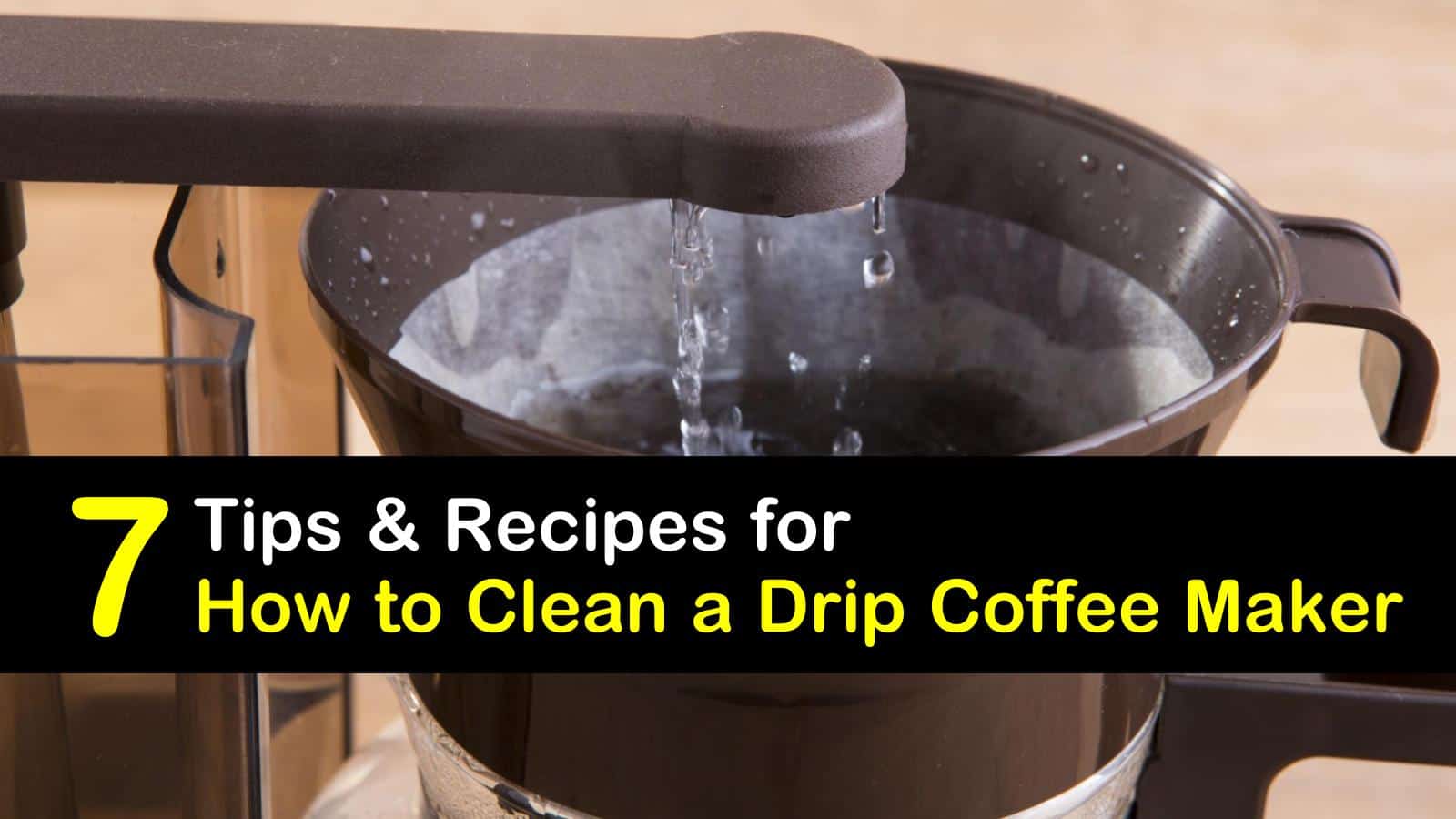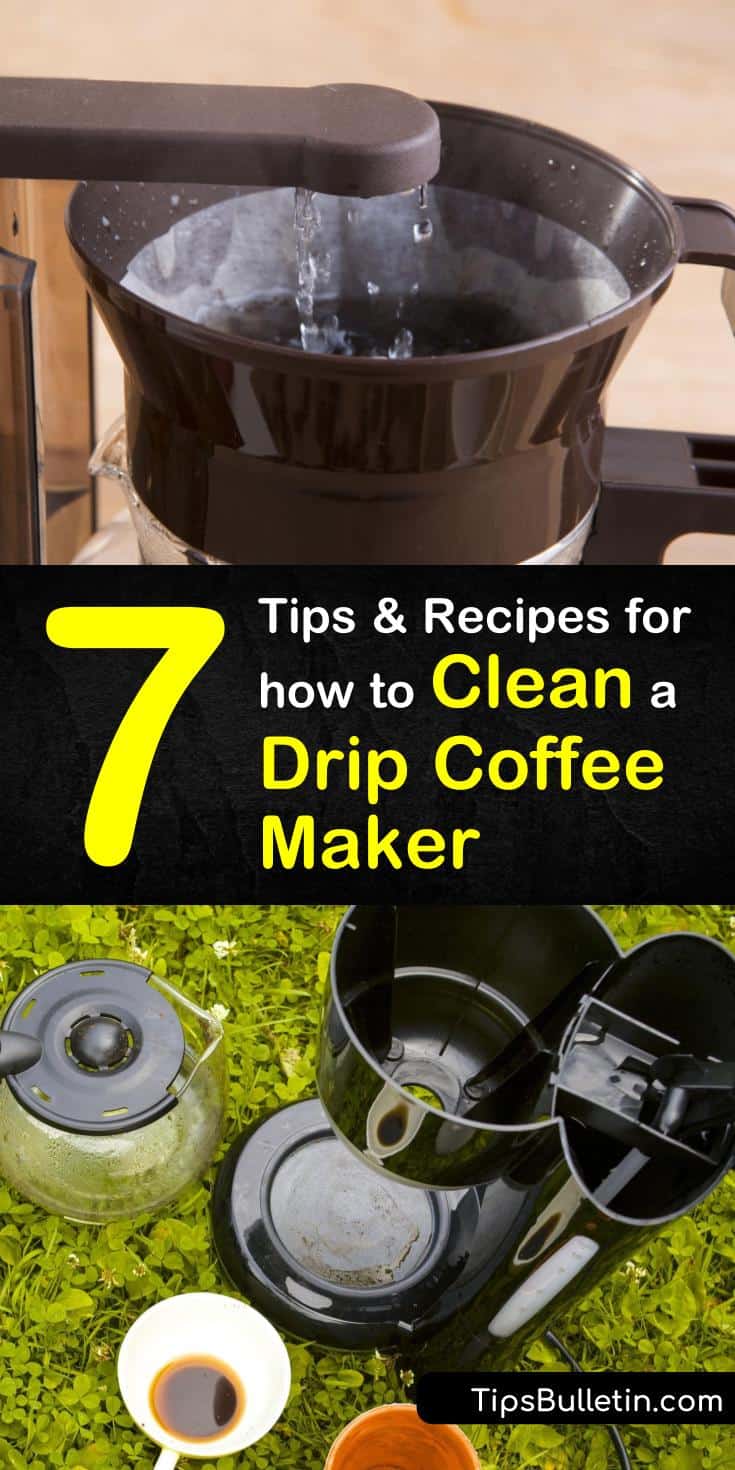There’s nothing better than a cup of coffee in the morning. However, since your coffee maker is such a commonly used item, it’s also probably one of the dirtiest in your house. It’s not an item you can throw in the dishwasher either, and that’s why it’s so important to learn how to clean a drip coffee maker the right way.
It might come as a surprise, but a 2011 study by NSF International revealed that coffee machines, the traditional kind with the filter basket, are the fifth germiest item in most homes. Of the houses studied, half of the coffee machines tested positive for yeast and mold in the water reservoir, and about ten percent had coliform bacteria(..).
While that might sound scary, these unhealthy conditions are preventable if you learn how to properly your coffee machine. With these simple tips and recipes, you can rest assured that you’re not only safe from dangerous bacteria and mold but that your coffee tastes great.

Cleaning a Drip Coffee Maker
The moist conditions involved in making coffee make it a breeding ground for mold and bacteria. To keep germs at bay, you should not only be cleaning out used coffee grounds when you finish brewing, but you should also be cleaning with more than hot water.
Check out our guidelines for how to clean coffee pots to ensure that your coffee is free from contaminants and that you can brew delicious coffee tomorrow morning.
Cleaning a Drip Coffee Maker
It’s vital to clean your coffee maker every day to avoid dirt buildup and germs. While it doesn’t require a deep cleaning after every use, you should wash the carafe, filter basket, and lid each day with warm, soapy water. Clean all removable parts after every use.
Cleaning a drip coffee maker also requires some monthly attention. On top of a daily scrub with warm water and dish soap, you should be descaling with vinegar once a month. Hard water locations need monthly cleaning, but areas with soft water only require decalcifying every two or three months.

How to Clean a Drip Coffee Maker with White Vinegar
Clean a drip coffee maker with white vinegar regularly to wash away mineral deposits. Mineral buildup forms when you use tap water and can clog up your machine and leave your coffee tasting off.
To decalcify your coffee machine, fill the water chamber with equal parts water and vinegar. Put in a paper filter and run a brew cycle, turning off the coffee maker when the chamber is half empty.
Let the cleaning solution sit in the coffee pot for approximately 30 minutes. Turn on the device again and finish the brew cycle. Put in a clean filter and brew a pot using fresh water.
Repeat once more to ensure that all the vinegar residue exits the coffee maker. Rinse the carafe and let it dry, and remember to wipe off the outside of the machine using a damp cloth. This simple procedure is the best way to descale a Keurig, Cuisinart or any coffee maker.
Fill Your Coffee Pot with Rice
If your carafe has stubborn coffee stains, you might need a gentle abrasive to remove the dirt and residue. Rice works well for this task.
Fill your pot with warm, soapy water and add a little bit of rice. Swirl the carafe to help loosen any debris that may be stuck on the insides. Grab a sponge and scrub until stains are gone. Rinse the pot with clean water once or twice and let it dry.
Wash Away Coffee Residue with Lemon Juice
Lemon juice is also an excellent ingredient to use for cleaning a drip coffee maker. First, run a cycle with clean water alone. This helps rinse away some of the coffee residue.
In a separate cup or bowl, mix half a cup of water and half a cup of lemon juice. While the machine is off, pour the lemon juice mixture into the water reservoir. Allow the solution to sit for 15 minutes, enough time to break down oils.
Place a clean paper filter in the machine and turn it on. Let a full brewing cycle run, then run one or two cycles with clean water only.
Use Baking Soda for a Clean Coffee Maker
One of the best cleaners in your kitchen is baking soda. Using it to clean your drip machine removes dirt and eliminates unwanted odors.
Fill the coffee pot with one cup of water and add in ¼ cup of baking soda. Swirl the carafe until the baking soda dissolves. Remove the filter from the machine and pour the cleaning solution into the reservoir.
Return the coffee carafe to its spot and let the device run a full cycle.Once the cycle finishes, run another cycle using clean water. Repeat until the water runs as clear as tap water.
Deep Clean Your Coffee Machine with CLR
Though all of the tips and recipes on this list are effective cleaners, sometimes you need a little extra cleaning strength. If you try our other cleaning solutions but find you are still having trouble with your coffee maker, it’s time for a commercial cleaner like CLR.
To start, run a normal cycle using clean water to get rid of any leftover residue from your last brew. Mix the CLR and water and pour it into the machine’s reservoir. Run a cycle.
If it’s been a long time since you’ve cleaned your coffee maker, then you may want to do one more run with a new mixture of CLR and water. Run a cycle with clear water again and repeat three or four times, until it doesn’t smell of CLR anymore.
Deep Cleaning a Keurig Machine
Single-cup coffee makers like Keurig have become incredibly popular. Though they might seem more challenging to clean, you can use any of the solutions on this list. First, you need to clean the exterior and all removable parts with a damp cloth and soapy water.
Use an old toothbrush to scrape away dirt and gunk for the empty k-cup holder. Reassemble the machine and place an empty mug on the tray and remove any old pods. Empty the water chamber and fill it with any of our cleaning solutions.
We recommend the vinegar mix. Select the largest cup brewing option and complete a cycle. Continue running it until you get the “Add Water” notification. Dump out the coffee mug with each brew.
Let the Keurig sit for about 30 minutes and then rinse the water reservoir until the vinegar residue is gone. Fill the container to the fill line with clean water and run as many cycles as it takes for it to empty.
While you’re taking care of your coffee maker it’s also a great time to clean the coffee grinder. The best coffee grinder cleaning solution is nothing more than some white rice. Pour the rice in the grinder and turn it on or manually grind it through.
Leftover coffee grounds will come out with the ground rice. Carefully wipe all residue from the compartment.
A simple clean of your coffee machine with soapy water goes a long way toward keeping it mold-free. However, if you want every cup to taste perfect, then you should also be descaling your machine every month. Use any of our cleaning solutions on a French press or other non-drip style machines, too.

If you learned how to clean a drip coffee maker with our helpful article, then share our coffee maker cleaning and descaling tips with your friends and family online.